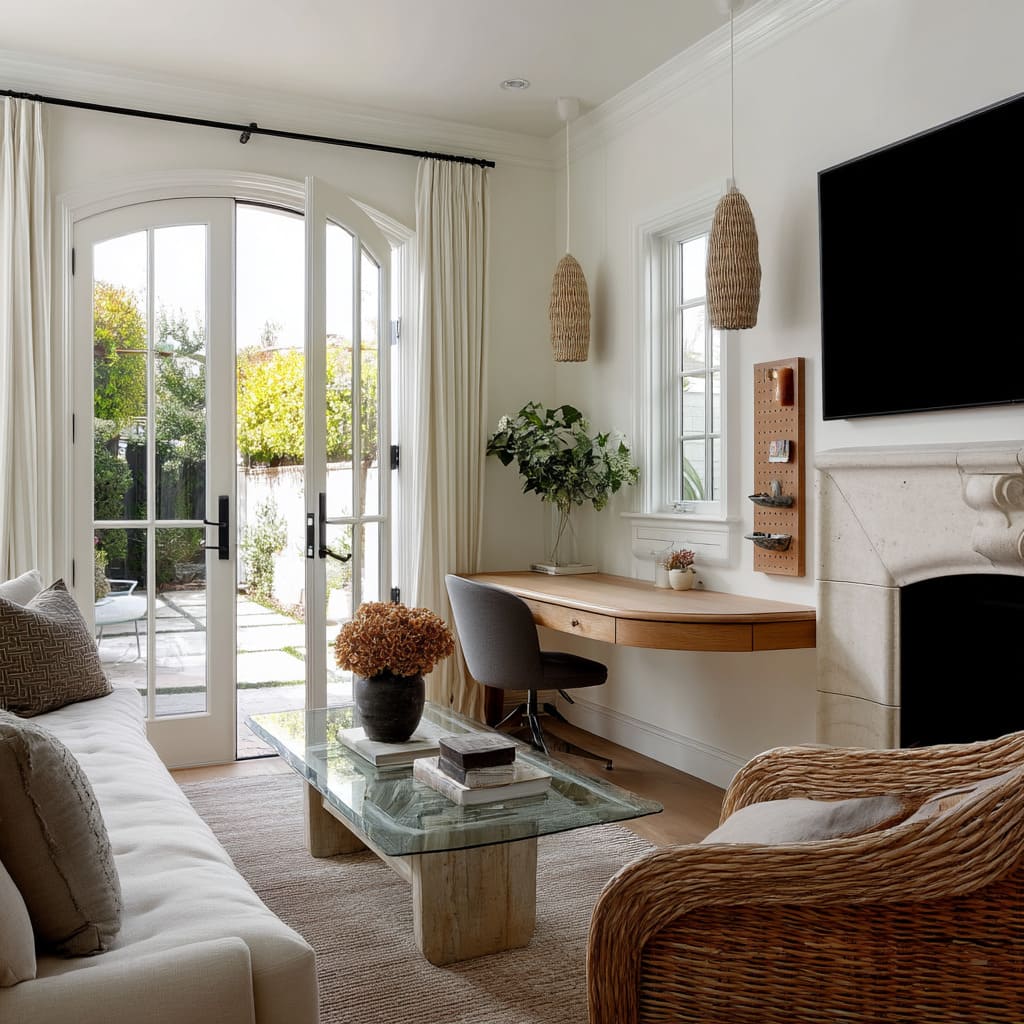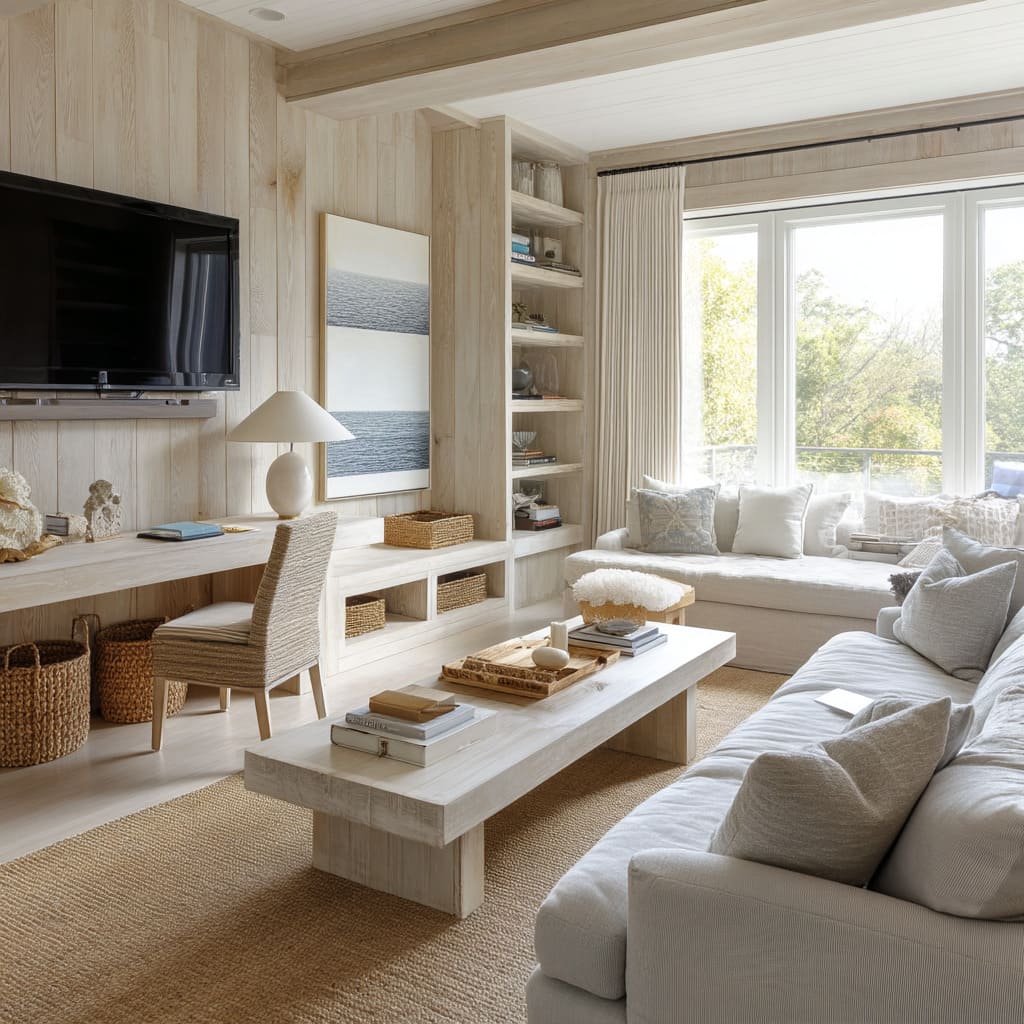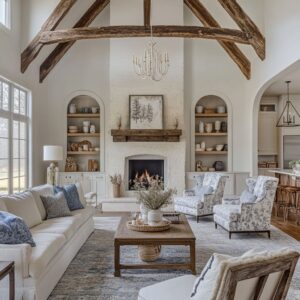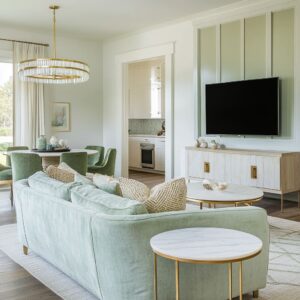The living room is no longer a single-purpose space. Across homes of all sizes—whether it’s a city apartment or a suburban house—more people are blending daily life with remote work, casual lounging, and focused productivity in the same square meters.
This shift has pushed designers to rethink what this kind of room can do, especially in ways that don’t clutter the layout or throw off the mood. Recent living room and office ideas show that it’s possible to merge both without turning the space into a compromise.
The best examples don’t scream “work zone”—instead, they embed a workspace into the bones of the room, aligning it with how people already use their homes. From corner desks that float near windows to full-length cabinetry that hides tech inside calm materials, the choices are subtle but highly intentional.
In this article, we take a detailed look at the newest ways designers are shaping shared spaces where focus and comfort work side by side. You’ll find ideas of how lighting, layout, furniture forms, and built-in tech are being used to create rooms that hold a desk without losing their feel as a place to relax.
Whether you’re planning a full remodel or making small changes, these insights can inspire for creating a space that fits both your workday and your downtime.
Zoning Tactics That Don’t Break Flow
One of the smartest moves designers make when planning office living room ideas is staying away from placing desks in the middle of the room. That’s not a coincidence.
Instead, workspaces tend to settle into the room’s quieter edges, especially where they won’t compete with TV lines or block access to windows. Placing the desk against a wall lets both zones breathe without interrupting each other—and still keeps everything in arm’s reach.
A window-facing desk niche is one of the most space-savvy setups you’ll find in high-end homes. It gives you direct natural light for reading or typing while automatically orienting your back away from the main seating zone, cutting down screen glare.
In several West Coast homes, you’ll notice how the entire wall surrounding the desk is wrapped in oak or light-toned wood, creating a visual cue that this zone is built-in—not a last-minute add-on.
A sofa-back console desk brings extra function without stealing square footage. Especially useful in open-plan layouts, this kind of desk often runs just behind a deep sectional or low sofa, acting as both divider and work surface.
The most functional versions hover between 350 and 400mm in depth—enough for a laptop and a lamp, but not so deep that it clutters the room. Stools, usually with slim frames or no backs, tuck neatly underneath and stay out of the way until needed.
Under-stair desks work best in traditional or colonial-style homes where staircases have enough depth and trim detail to frame the desk as part of the architecture. These setups often match the desk’s finish to the trim or wall paint, making it feel like a continuation of the stair volume instead of an interruption.
Add a pair of recessed spotlights or a compact swing-arm lamp, and you’ve got a highly functional work corner that doesn’t cut into walkways. Fold-away or rolling desks are a clever solution in small or urban homes.
Designs seen in Minneapolis or the Midwest sometimes hide the entire office setup behind bi-fold cabinet doors or place it on vintage-style wheels. These pieces can be moved or closed up in seconds, giving you the flexibility to hide the workspace during downtime.
The cabinetry usually uses continuous wood grain and exposed hinges to signal high build quality, even when closed.
Corner-mounted floating desks add a surprising softness to what’s often an overlooked space. Especially in homes with a fireplace or angled walls, rounding the desk edge rather than forcing a 90-degree shape helps it sit more naturally within the room.
Designers frequently echo the curve in other elements—like an arched fireplace trim or a rounded coffee table—so the room reads as cohesive rather than segmented. The unspoken logic behind all of these office sitting room ideas?
Every one of them keeps a main wall clean—either for full-height windows, art, or shelving. There’s a consistent preference for letting the lounge zone stretch freely, while the office quietly occupies the margin.
It’s that careful restraint that keeps these rooms feeling open, even when they’re working hard.
Invisible Architecture: how the office dissolves into the lounge
| Hidden‑in‑plain‑sight move | Why it matters | Practical cue |
| millwork wall that swallows desk + TV | keeps screens, wires and storage on a single datum so the lounge still feels calm | continue one material (oak, walnut, limestone or plaster) floor‑to‑ceiling; carve desk and shelves from the same sheet before adding reveals |
| floating or cantilevered worktop | shows the floor plane, lets rugs run under, and tricks the eye into reading the desk as part of the wall, not a freestanding object | recess steel angles inside the wall; stop legs at least 150mm behind drawers |
| soffit or dropped shelf that hides light | washes timber or stone in a glow, removes the need for desk lamps, and keeps task lighting out of sightlines | set LED strip 40‑60mm behind shelf front; pick 2700–3000K to match domestic warmth |
| three‑sided frame around a TV or monitor | floats the screen, equalises weight with shelving, and avoids a black rectangle eating the wall | leave a 5–8mm shadow gap on all sides rather than flush‑mounting |
Key Insight: the joinery itself carries the aesthetic load; furniture becomes secondary.
Furniture Geometry: Soft Curves Against Strict Lines
There’s a visible rhythm in how today’s designers combine work zones and lounge seating: straight lines for the office, and curves for comfort. It’s more than just visual balance—it’s about guiding the way people move through the space.
A curved ottoman or a boucle armchair with a wide barrel back lets you pass by without bumping into corners, making the layout feel relaxed even when square footage is tight.
Rounded sofas, pebble-shaped ottomans, and boucle-clad chairs show up again and again in these hybrid rooms, especially in Californian and coastal homes. The softness they bring contrasts against the harder lines of desks and shelving, drawing a clear but quiet line between work and rest.
These forms are more than a style choice—they shape how people interact with the room. Even when a desk is placed just behind a sofa or off to the side, curved forms around it prevent the space from feeling boxed in.
Desk chairs, even when ergonomic, often borrow materials from the sofa—boucle, pale leather, or textured linen. You’ll spot sculpted chairs with a tub or bucket shape, low backs, and swivel or castered bases that blend in with the rest of the furniture.
This isn’t office supply catalog territory—these pieces match the palette and style of the home, so the workspace doesn’t scream for attention.
Instead of one big coffee table, a trio of smaller low tables is often used, especially when the desk is part of the same space. These multi-part setups allow furniture to be moved quickly when someone rolls out from the desk, sits on the floor, or needs extra surfaces during casual meetings or family activities.
The mix usually includes soft forms—rounds, poufs, or squarish cubes—so everything stays visually light. The desk zone keeps its structure: flat lines, square corners, and clear spacing.
But the lounge soaks up the comfort. That contrast is what makes the combo work—keeping productivity clear without letting it take over the room.
Material stories: subtle rhythm instead of accent colour
| Palette family | Typical pairing | Вesign intent |
| Pale oak + matte cream | low‑gaussian boucle, light limestone | West‑coast rooms favour inside‑outside flow and soft shadow play |
| Walnut + chalk white | brass or aged bronze, off‑black frames | Mid‑century or revival feel with sharper contrast |
| Sage / soft olive + honey oak | black hardware lines | a muted green thread links, signalling a move toward tone‑on‑tone colour rather than bold accent walls |
| Travertine / limestone + warm grey plaster | camel or rust textiles | desert modern sets, letting stone texture replace pattern |
| Charcoal ribbed timber + slate textiles | rust cushions, brushed steel | cooler climate rooms can lean into darker wraps for coziness |
Not obvious but recurring: repeating the primary timber species on at least three different elements–desk, shelves and floor or desk, stair rail, window seat–to stop the workspace from feeling “added on. ”
Light as Furniture
In homes where the desk sits inside the living room, light isn’t just an afterthought—it’s part of the layout. More and more, lighting is built right into the structure, shaping how the space looks and feels without relying on freestanding lamps that clutter surfaces or block sightlines.
Shelf-edge LEDs are a prime example. You’ll see these tucked along the bottom of floating shelves above desks, casting a soft glow across wood grain or textured stone.
This kind of light quietly marks the work zone without calling attention to itself. It also removes glare on glossy screens by bouncing the light across a matte surface instead of shining directly from above.
Black swing-arm sconces are another go-to move, especially in transitional and modern spaces. These mount directly to the wall, usually just above or to the side of the desk, and can be aimed where needed.
Their thin, angular profile avoids adding bulk and keeps the wall line crisp. Some even match existing window frames or cabinet pulls in finish, tying the piece back into the room without creating visual noise.
Rod pendants and arc lights are more often placed in the lounge area, but their position still matters to the desk. By tracing the line of the sofa or angling away from the screen zone, they bring layered light into the room without overpowering the work corner.
In several West Coast homes, designers chose oversized pendant forms with soft bulbs that reflect off pale plaster or whitewashed walls, keeping the overall effect low-contrast and calm.
This kind of setup works because it builds in layers—task lighting at desk level, ambient wash along the wall, and broader glow over the lounge. It keeps screens readable, faces evenly lit, and the space usable at all hours.
Most important: it does so without needing extra floor lamps or overhead can lights that disrupt the ceiling rhythm. Among today’s office and sitting room ideas, this subtle, built-in lighting language is one of the most defining traits of well-planned shared spaces.
Quiet Tech Integration Trends
The best office ideas in a living room today are as much about what you don’t see as what you do. Technology has become quieter—not in volume, but in visibility.
That shift has changed how designers plan such rooms, favoring seamless setups that blend tools into the background rather than putting them on display.
Flush-mounted or lightly floating TVs are one example. Instead of letting the screen dominate the wall, designers now recess it slightly or frame it inside built-in panels.
This keeps the surface clean, reduces reflections from lighting, and lets art, shelves, or millwork share the spotlight.
Desk depth rarely exceeds 600mm, and in many cases, it’s even shallower. That’s because most people now work from a laptop or slim monitor, so there’s no need for deep, bulky surfaces.
Instead, the width of the desk expands to offer more lateral space, often stretching the full length of a wall, letting two people work side-by-side without feeling cramped.
That leads into another trend: dual-chair or stool setups. In several recent rooms, especially in shared family homes, designers included two desk chairs or even a bench to reflect how these spaces are often used by more than one person.
Whether it’s a parent and child, two partners working remotely, or just someone sharing notes with a visitor, the layout suggests collaboration more than isolation.
Finally, charging and power points are being hidden. You’ll find induction charging pads embedded beneath wood veneers, USB ports inside soft-close drawers, and cord management routed through gaps behind shelves.
In the most refined setups, even the lamp wiring is hidden inside hollow desk legs or shelf panels, maintaining that clean, quiet surface across the whole room. Altogether, these choices point to a shift: today’s office-living combos aren’t trying to show off technology—they’re making space for it without letting it take over.
The tech is there, but the room still reads like a living space first. That’s the balance more people are looking for—and these hidden cues are how it’s done.
Guidance grid for your own living‑office combo
| Goal | Move | Supporting detail from study |
|---|---|---|
| Keep lounge dominant | push desk to perimeter, float it to show rug | every room with console‑back or wall niche kept sofa sightlines clear |
| Avoid “workspace glare” | choose 2700–3000K shelf LEDs + matte desktop finish | matte oak, travertine, boucle everywhere—zero gloss tops |
| Future‑proof storage | mix closed drawers (60%) + open display (40%) | alternating rhythms keep shelves lively yet tidy |
| Blend with architecture | carry one material across three planes | ceiling soffit + desk + shelves in same oak |
| Support shared use | allow at least 1400mm clear desk run for two seats | dual chair setups appear in 20% of cases and keep foot traffic flowing |
Where Designers Are Pushing Next
There’s a visible shift happening in how the office living room combo is being approached—not only in layout, but in how designers shape the actual materials and forms. The newest ideas show a quiet but smart expansion of what this hybrid space can do—without ever making the room feel like a workspace took over the lounge.
One emerging move is using curved stone or plaster desks. These aren’t just rounded for the sake of softness—they respond to tight corners, angled walls, or transitional spots in smaller homes.
A curved surface avoids the tension of sharp edges and allows better flow in narrow rooms. Designers often shape these as thick, solid forms—using honed limestone, cast terrazzo, or microcement finishes that feel more like part of the wall than a separate desk unit.
The curvature also connects naturally with arched windows or rounded mantels in the same room, giving a subtle sense of continuity.
Another growing idea—especially in urban homes—is fold-away micro offices. These setups often live behind bi-fold doors, inside cabinetry that reads like shelving or a wardrobe when closed.
During the week, the space opens into a full-function desk zone. On weekends, it folds back into the background.
It’s especially common in apartments or smaller houses where space needs to do double duty but still look finished. These units frequently include hidden lighting, charging ports, and even cork or fabric-lined walls for sound control—yet remain nearly invisible when not in use.
A more open approach shows up in sofa-back desks with built-in power strips, where lounging and laptop use happen in the same footprint. This works well in larger open plans or rooms with wide sightlines.
Instead of adding a full office corner, designers install a long, shallow desk behind the sofa, where people can respond to emails, plug in a tablet, or work with a view of the TV or fireplace. The key here is comfort and casual use—supported by easy access to charging, stools that disappear when not used, and finishes that match the rest of the room.
One of the most refined updates being explored is material continuity between fireplace surrounds and desk slabs. In some of the most seamless home office in a living room layouts, the desk isn’t a standalone item—it shares its surface or cladding with the fireplace just a few feet away.
The same stone or wood carries across, uniting the two zones and allowing the workspace to blend into the rhythm of the room’s architecture. You’ll often find the grain of oak, the veining in travertine, or the tone of painted paneling extending in one clean line from hearth to worktop.
Final Insight
What’s consistent across the strongest spaces is this: the office isn’t treated like an add-on—it’s folded into the structure. That means the desk, lighting, storage, and power elements are all wrapped into one thought-out volume.
Nothing stands apart. Nothing looks like it was placed there last minute.
At the same time, the softness—curves, textiles, layered light—stays anchored in the lounge seating, which carries warmth and flexibility.
This way, the entire room can shift roles throughout the day. It can be a place to relax, a place to focus, or both—without any piece feeling out of place.
There are no cables sprawled across surfaces, no mismatched furniture pieces dragging the energy down. It’s all part of a single system.
That’s the kind of quiet clarity defining the next wave of mixed-use living spaces.































